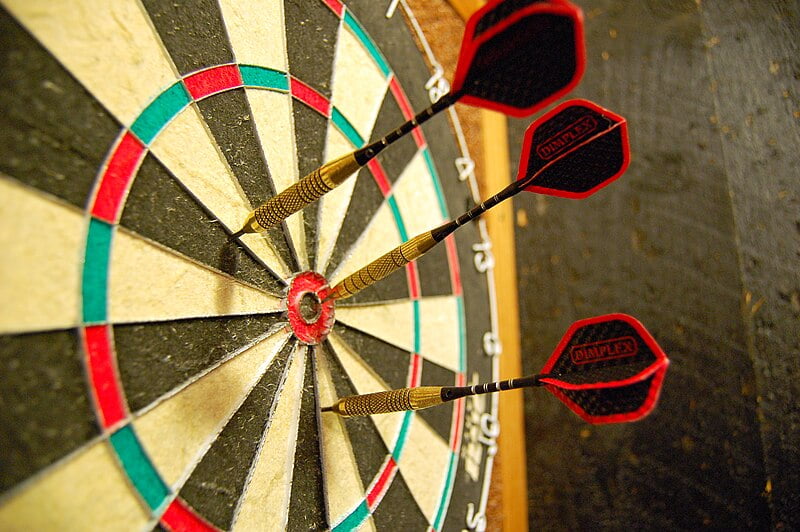Introduction to Dart board
Dart boards have been a staple in pubs, game rooms, and homes for decades. Whether you’re a casual player or a serious competitor, understanding the different types of dart boards, how to set them up, maintain them, and play effectively can enhance your experience. Dart boards are circular targets used in the game of darts, where players throw sharp-tipped darts at the board to score points. The most common type of dart board is the bristle board, made from compressed sisal fibers, which allows for self-healing after darts are removed, ensuring a durable and consistent playing surface. Dart boards typically feature a series of numbered sections, with the bullseye at the center, and are designed for various games, the most popular being “501” and “Cricket.
The game of darts has a rich history that dates back to the late 19th century in England. Originally, players used the bottom of a wine barrel as the target, and the game evolved over time into the standardized format we know today. The first official dart board was made from wood, but modern boards are typically made from sisal fibers, which are more durable and provide better self-healing properties.
Types of Dart Board
Understanding the different types of dart boards available can help you choose the right one for your needs.
1. Bristle Dart Boards
Bristle dart boards are made from compressed sisal fibers, which allow the board to self-heal after a dart is removed. This type of board is preferred by serious players because it offers a consistent playing surface and durability.
2. Electronic Dart Board
Electronic dart boards are equipped with sensors that automatically calculate scores, making them user-friendly for beginners. They often come with built-in games and sound effects, adding a fun element to the game.
3. Magnetic Dart Board
Magnetic dart boards are great for kids or casual play. The darts have magnets instead of sharp tips, making them safe for all ages. However, they do not provide the same level of playability as bristle or electronic boards.
4. Cork Dart Board
Cork dart boards are less common but can be found in some casual settings. They are made from cork material and are generally less durable than sisal boards.
Choosing the Right Dart Board
When selecting a dart board, consider the following factors:
- Skill Level: Beginners may prefer electronic or magnetic boards, while experienced players should opt for bristle boards.
- Space: Ensure you have enough space for the board and the throw line. A standard dart board should be hung at a height of 5 feet 8 inches from the floor to the center of the bullseye.
- Budget: Dart boards range in price. Bristle boards are typically more expensive but offer better longevity.
Setting Up Your Dart Board
Setting up your dart board correctly is crucial for an enjoyable playing experience. Here’s a step-by-step guide to help you get started.
Step 1: Choose the Right Location
Select a location that is clear of obstacles and provides enough space for players to throw darts. Ideally, you should have at least 11 feet of clearance from the dart boards to the throw line (also known as the oche).
Step 2: Mark the Height
The standard height for hanging a dart board is 5 feet 8 inches from the floor to the center of the board. Use a measuring tape to ensure accuracy.
Step 3: Secure the Dart Board
Most dart boards come with a hanging bracket. Secure the board to the wall, ensuring it is level.
Step 4: Establish the Throw Line
Step 5: Lighting and Safety
Ensure the dart board is well-lit to avoid shadows that could hinder your aim. Additionally, establish a spectator area that is safe from stray darts.
Maintenance Tips for Your Dart Board
To prolong the life of your dart board, regular maintenance is essential. Here are some tips to keep your board in top condition:
1. Keep It Dry
Moisture can warp a dart boards, especially those made from sisal. Ensure your dart board is in a dry, well-ventilated area.
2. Avoid Direct Sunlight
Direct sunlight can dry out the board, causing it to crack. Position your board away from windows or use curtains to block sunlight.
3. Use Quality Darts
Using high-quality darts can reduce wear on the board and improve your game. Cheaper darts may not fly straight and can damage the board more easily.
4. Cover When Not in Use
Covering your dart board can protect it from dust, moisture, and light when not in use, helping to maintain its condition.
5. Remove Darts Carefully
Always twist the darts out instead of pulling them straight out. This prevents damage to the board’s fibers.
Playing the Game: Rules and Scoring
Darts can be played in various formats, but the most common is “501.” Here’s a brief overview of how to play:
Basic Rules
- Starting the Game: Each player starts with a score of 501. The objective is to reduce your score to exactly zero.
- Scoring: Players take turns throwing three darts per round. The score for each dart is determined by where it lands on the board.
- Ending the Game: To win, a player must reach exactly zero by hitting a double or the bullseye on their final dart.
Common Variations
- Cricket: Players aim to hit numbers 15 through 20 and the bullseye. The objective is to “close” these numbers while scoring more points than the opponent.
- Around the World: Players must hit each number on the board in order, from 1 to 20, and finish with the bullseye.
Conclusion
Dart boards provide a fun and engaging way to spend time with friends and family. By understanding the types of dart boards available, how to set them up, maintain them, and the rules of the game, you can enhance your dart-playing experience. Whether you’re playing casually or competitively, the joy of throwing darts is timeless. So grab your darts, set up your board, and enjoy the game!
FAQs
What is the best type of dart board for beginners?
Electronic dart boards are often recommended for beginners due to their ease of use and automatic scoring.
How often should I rotate my dart boards?
It’s advisable to rotate your dart boards every few months to ensure even wear on the playing surface.
Can I use regular darts on an electronic dart boards?
No, electronic dart boards require soft-tip darts to avoid damaging the sensors.
How do I clean my dart board?
Gently brush the board with a soft brush to remove dust and loose fibers. Avoid using water or cleaning solutions.
What is the standard height for a dart board?
The standard height for a dart boards is 5 feet 8 inches from the floor to the center of the bullseye.












